Unlock Premium, Members-Only Content
Your source for the most relevant updates in sustainable construction
Biophilic design is an innovative approach to designing buildings, spaces, and communities that seeks to integrate elements of nature into the built environment to improve people’s health, well-being, and overall quality of life.
With increasing recognition of the many benefits of nature for human health and well-being, biophilia has gained popularity as a way to bring the outdoors inside and to create more livable, enjoyable, and sustainable environments.
Biophilia can be applied to various types of buildings and lengths, from homes and offices to schools, hospitals, and public spaces. It can be achieved by incorporating natural elements such as plants, water features, and raw materials and by designing outdoor spaces that encourage people to spend time outdoors.
This article explores the principles and key features of biophilic design, the benefits of the biophilic plan for health and well-being, and how technology and sustainable design principles can be incorporated into biophilic design.
We invite you to read on to learn more about this exciting and transformative design approach and discover how you can bring the benefits of nature into your own home or work environment.
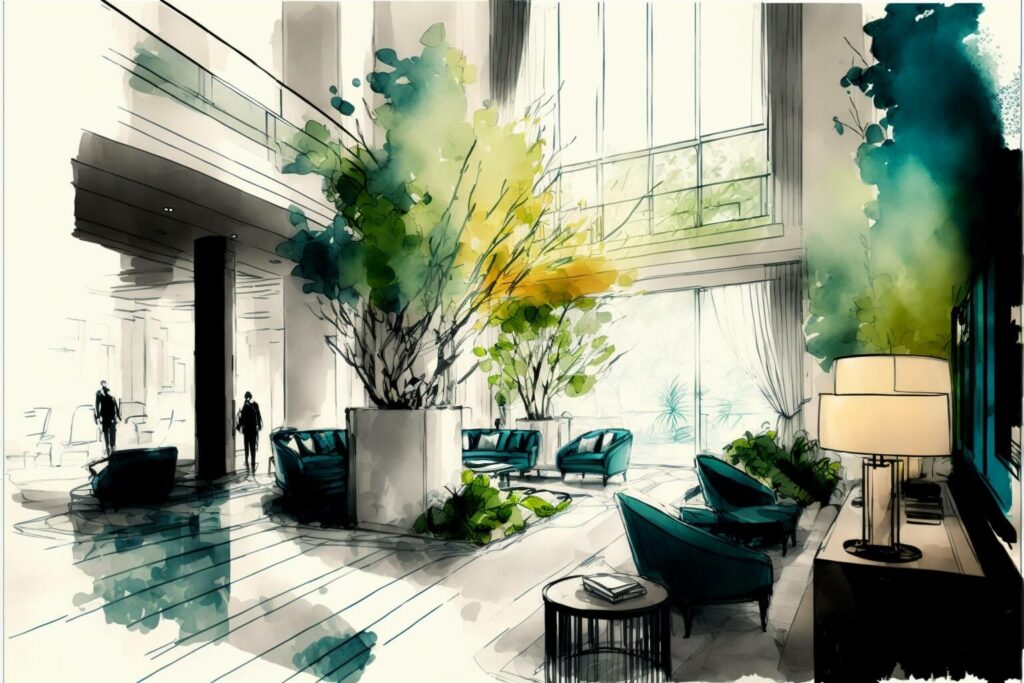
What is biophilic design, and how does it work?
Biophilic design is an approach to designing buildings, spaces, and communities that seeks to integrate elements of nature into the built environment to improve people’s health, well-being, and overall quality of life.
This can be achieved by incorporating natural ingredients such as plants, water features, and raw materials and by designing outdoor spaces that encourage people to spend time outdoors.
Biophilic design can be applied to many buildings and areas, including homes, offices, schools, hospitals, and public spaces. It is based on several fundamental principles, such as integrating natural elements into the built environment, creating connections with nature, and using natural patterns and processes.
Biophilia has been shown to have many benefits, including improved health and well-being, enhanced cognitive function and productivity, increased social cohesion and community building, environmental sustainability, and economic benefits.
There can be challenges in implementing biophilia, such as cost, limited space, and the need to integrate it into existing built environments.
Technology can enhance biophilic design’s effectiveness through virtual reality and other interactive tools, intelligent building systems, monitoring and data collection, education and outreach, and design and visualization tools.
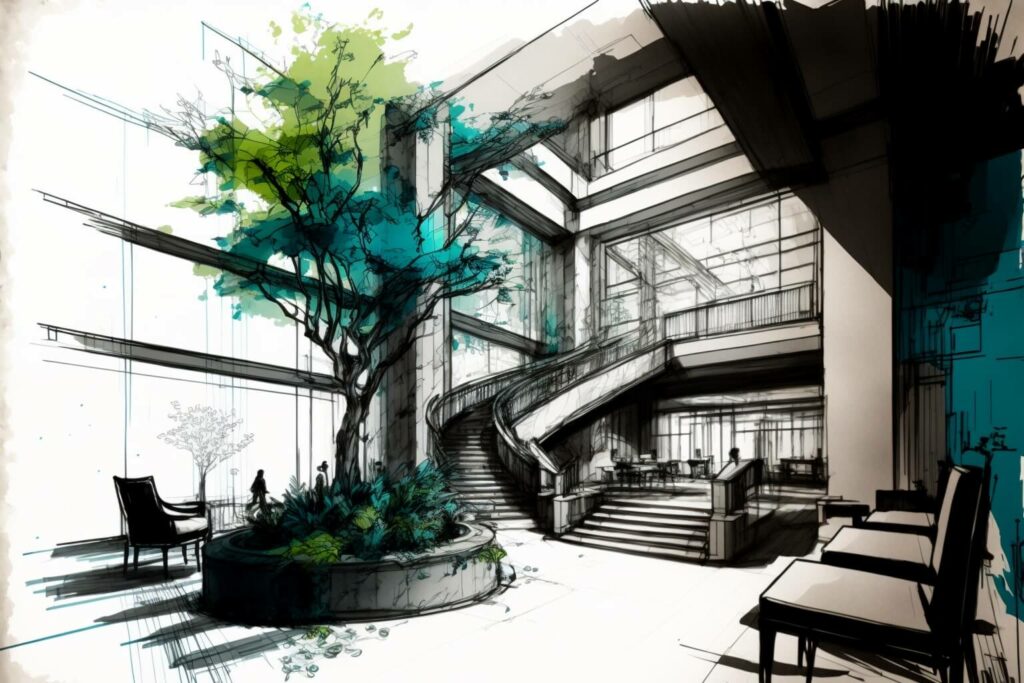
What are the benefits of biophilic design?
Biophilic design has been shown to have a range of benefits for health and well-being. Some of the specific ways in which biophilia can improve health and well-being include:
- Reducing stress: Exposure to nature and biophilic design elements has been shown to reduce stress and improve overall well-being. This can be particularly beneficial in high-stress environments such as hospitals and offices.
- Improving mental health: biophilia has also been linked to improved mental health, such as reduced symptoms of depression and anxiety.
- Enhancing cognitive function and productivity: Exposure to nature and biophilic design elements has improved cognitive function, creativity, and productivity. This can be especially beneficial in work environments, where access to natural light and views of nature has been shown to improve performance and job satisfaction.
- Improving cardiovascular health: Studies have also shown that exposure to nature can improve cardiovascular health by lowering blood pressure and heart rate.
- Faster recovery times in hospitals: Biophilic design has also been shown to improve patient outcomes and speed up recovery times in hospitals through the use of natural light and views of nature, incorporating plants and other natural elements, and the design of outdoor spaces for relaxation and healing.
Unlock Premium, Members-Only Content
Your source for the most relevant updates in sustainable construction
How can biophilic design be applied to different types of buildings and spaces?
Biophilic design can be applied to a wide range of different types of buildings and spaces, including:
- Homes: Biophilic design can be incorporated into homes in various ways, such as through the use of indoor plants and green walls, the incorporation of natural materials such as wood and stone, and the design of outdoor spaces for relaxation and recreation.
- Offices: Biophilic design can also be applied to office environments, such as through the use of natural light and views of nature, the incorporation of plants and raw materials, and the design of outdoor spaces for breaks and relaxation.
- Schools: Biophilia can be particularly beneficial in educational settings, such as schools, as it has been shown to improve cognitive function, creativity, and overall well-being in students. This can be achieved by incorporating natural elements into classrooms and school grounds and designing outdoor spaces for learning and play.
- Hospitals: Biophilia can also be applied to healthcare settings, such as hospitals, to improve patient outcomes and overall well-being. This can be achieved through using natural light and views of nature, incorporating plants and raw materials, and designing outdoor spaces for relaxation and healing.
- Public spaces: Biophilic design can also be applied to public spaces, such as parks, plazas, and streetscapes, to create more livable and enjoyable environments for people. This can include incorporating natural elements such as plants, water features, and raw materials, as well as the design of outdoor spaces that encourage people to spend time outdoors.
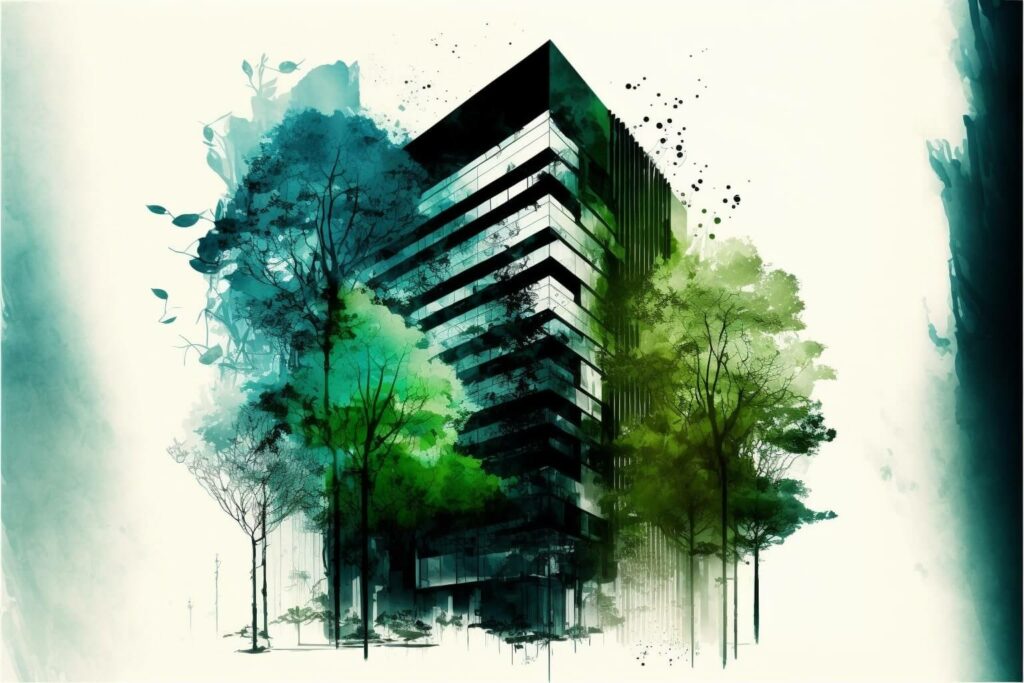
What are the challenges of implementing biophilic design?
There can be challenges in implementing the biophilia in practice, including:
- Cost: One of the main challenges can be costly, as incorporating natural elements and systems into the built environment often requires a higher upfront investment.
- Limited space: Another challenge can be limited space, as it may not always be possible to incorporate large amounts of nature into small or densely built environments.
- Integration into existing built environments: Integrating biophilia into existing built environments can also be challenging, as it may require building retrofitting or modifying outdoor spaces.
- Maintenance and upkeep: The maintenance and upkeep of natural elements and systems can also be challenging, as they may require more frequent attention and care than traditionally built elements.
- Education and awareness: There may also be challenges in education and awareness, as it may be necessary to educate people about the benefits of biophilia and how to incorporate it into their spaces.
- Regulation and codes: There may also be regulatory and code-related challenges to implementing biophilic design, as it may require the modification of existing building codes or the development of new standards.
- Funding and financing: There may also be challenges in funding and financing the implementation of biophilic design, as it may require allocating additional resources or developing new financing mechanisms.
What are the principles of biophilic design?
Biophilic design principles are based on integrating elements of nature into the built environment to improve people’s health, well-being, and overall quality of life.
Some of the critical principles of biophilic design include the following:
- Connection with nature: The first principle of biophilia is the idea of creating a connection with nature, which can be achieved through the incorporation of natural elements such as plants, water features, and raw materials, as well as through the design of outdoor spaces that encourage people to spend time outdoors.
- Natural light and views of nature: Another critical principle of biophilia is the incorporation of natural light and views of nature into buildings and spaces, which can have several benefits for human health and well-being, including the regulation of sleep patterns, the improvement of mood and mental health, and the enhancement of cognitive function and productivity.
- Natural patterns and forms: Biophilia also involves the incorporation of natural patterns and structures into buildings and spaces, such as the use of organic shapes, textures, and materials that mimic or are inspired by nature.
- Biomimicry: Biomimicry is a principle of biophilia that involves the use of natural forms and processes as inspiration for innovation, such as the use of raw materials, shapes, and systems to create more sustainable and efficient buildings and spaces.
- Sensory engagement: Finally, the biophilia seeks to engage the senses of people through the incorporation of natural elements such as plants, water features, and raw materials, as well as through the use of natural light, views of nature, and other sensory stimuli.
Unlock Premium, Members-Only Content
Your source for the most relevant updates in sustainable construction
Unlock Premium, Members-Only Content
Your source for the most relevant updates in sustainable construction
How can biophilic design contribute to environmental sustainability?
Biophilic design can contribute to environmental sustainability in several ways, including:
- Reduction of energy use: Biophilia can reduce energy use by taking advantage of natural light and ventilation and incorporating features such as green roofs and rainwater harvesting that can reduce the need for artificial lighting and irrigation.
- Improvement of air quality: Biophilic design can also improve air quality by incorporating plants and other natural elements that can filter and purify the air.
- Preservation of natural habitats: Biophilian can also contribute to conserving natural habitats by incorporating natural elements into the built environment and minimizing the impact of development on natural areas.
- Promotion of sustainable materials and systems: Biophilia can also promote using sustainable materials and techniques, such as using natural materials and incorporating sustainable features such as green roofs and rainwater harvesting.
- Encouragement of outdoor activities and conservation: Biophilic design can also encourage people to spend time outdoors and to appreciate nature, which can, in turn, promote conservation and sustainable practices.
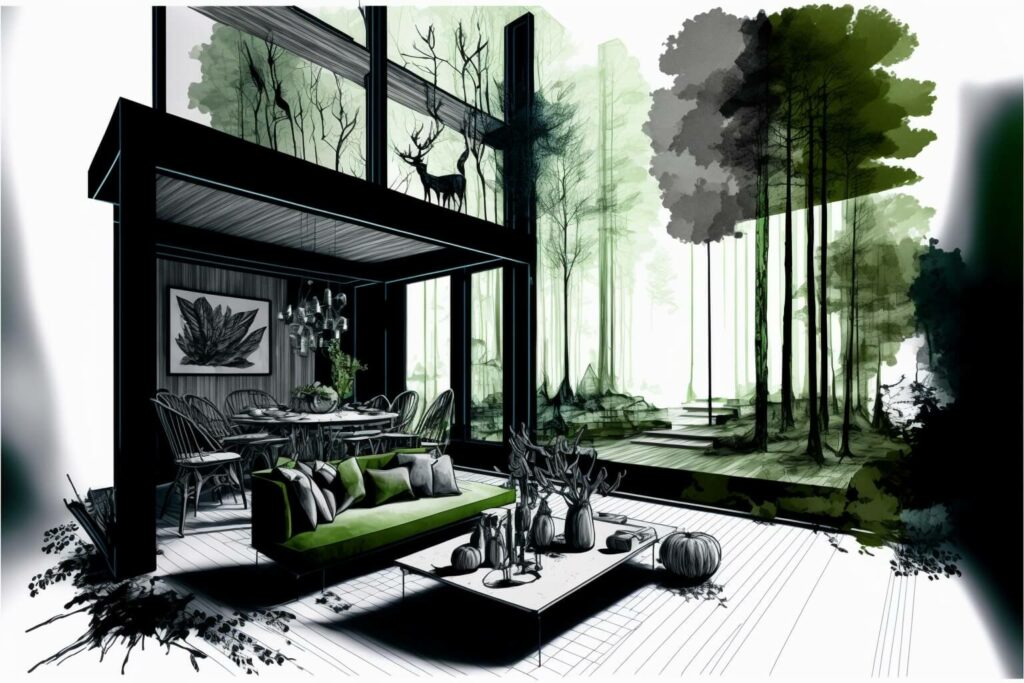
How can biophilic design improve health and well-being?
Biophilia can improve health and well-being in several ways by providing people with a greater connection to nature and incorporating natural elements that have been shown to affect health and well-being positively. Some of how biophilic design can improve health and well-being include:
- Reducing stress: Biophilic design can help reduce stress by providing people with a sense of calm and relaxation by incorporating natural elements such as plants, water features, and raw materials. The presence of nature has been shown to have several stress-reducing effects, including lowering heart rate, blood pressure, and cortisol levels and improving overall mood.
- Improving mental health: Biophilia can also help to improve mental health by providing people with a sense of calm and relaxation and increasing overall satisfaction with the environment. The presence of nature has been shown to have several positive effects on mental health, including the improvement of mood, the reduction of anxiety and depression, and the improvement of overall cognitive function.
- Enhancing cognitive function and productivity: Biophilia can also help to improve cognitive function and productivity by providing people with a sense of calm and relaxation and increasing overall satisfaction with the environment. Studies have shown that people working in environments with natural elements such as plants, natural light, and views of nature tend to be more productive, focused, and creative.
- Improving cardiovascular health: Finally, biophilic design can help to improve cardiovascular health by providing people with an opportunity to engage in physical activity, such as walking or biking in outdoor spaces, and by improving overall air quality and reducing exposure to pollutants. The presence of nature has been shown to have many positive effects on cardiovascular health, including lowering heart rate, blood pressure, and cholesterol levels and improving overall cardiovascular fitness.
What are some examples of biophilic design in practice?
Some examples of applied biophilic design include:
- The High Line, a public park built on an abandoned elevated railway in New York City, features a variety of plantings, seating areas, and public art installations and provides a unique connection with nature in the city’s heart.
- The Green School in Bali, Indonesia, is a sustainable school built from natural materials and featuring a variety of green spaces, including gardens, a rice paddy, and a bamboo forest, as well as several outdoor classrooms and learning spaces.
- The Green Tower in Seoul, South Korea, is a high-rise building with a green wall on one side and many other green spaces and sustainable features, such as rainwater harvesting, energy-efficient lighting, and a green roof.
- The Bosco Verticale in Milan, Italy, is a pair of residential towers with vertical gardens on their facades, providing a unique connection with nature in the city’s heart.
- The Eden Project in Cornwall, England, is a collection of large greenhouse-like structures that house various plant species and provide visitors with educational and recreational opportunities.
- The National Arboretum in Canberra, Australia, is an extensive collection of trees and other plant species and features several outdoor spaces, including walking trails, picnic areas, and educational facilities.
What is the future of biophilic design?
The future of biophilic design is likely to involve integrating technology and sustainability to create more livable, enjoyable, and sustainable environments. Some of the key trends and developments in biophilic design that are likely to shape the future include:
- The use of technology to enhance the connection with nature: Biophilia is likely to make increasing use of technology to improve the relationship with nature, such as through the use of virtual reality, augmented reality, and other digital technologies that allow people to experience nature in new and immersive ways.
- The integration of biophilic design with sustainability: Biophilic design is also likely to become increasingly integrated with sustainability as designers seek to create buildings and spaces that are more energy-efficient, water efficient, and environmentally friendly. This may involve using green roofs, rainwater harvesting, and other sustainable features, as well as incorporating natural elements such as plants and other living systems that can help purify the air and improve overall well-being.
- The development of new materials and technologies: The future of biophilic design may also involve the development of new materials and technologies that are more sustainable and allow designers to create more natural and organic forms and structures. This may include the use of biomimicry, which involves the use of natural forms and processes as inspiration for design, and the development of new, more sustainable materials that can be used in the construction of buildings and spaces.
- The expansion of biophilic design into new areas and applications: Finally, the future of biophilic design is likely to involve the development of biophilic strategy into new sites and applications as designers seek to create more livable, enjoyable, and sustainable environments in a variety of different contexts, including homes, offices, schools, hospitals, and public spaces.
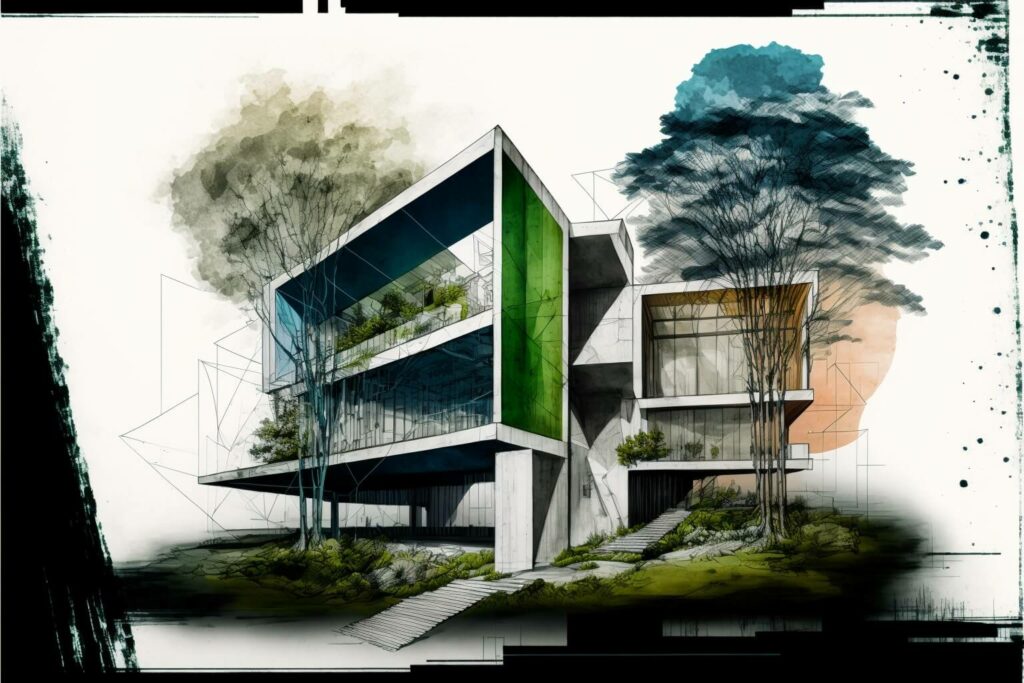
Conclusion
As we have seen, biophilic design is an exciting and transformative approach to designing buildings, spaces, and communities that seeks to integrate elements of nature into the built environment to improve the health, well-being, and overall quality of life of people.
With increasing recognition of the many benefits of nature for human health and well-being, the biophilic design offers a powerful way to bring the outdoors inside and to create more livable, enjoyable, and sustainable environments.
Biophilia can be applied to various types of buildings and lengths, from homes and offices to schools, hospitals, and public spaces. It can be achieved by incorporating natural elements such as plants, water features, and raw materials and by designing outdoor spaces that encourage people to spend time outdoors.
Suppose you are interested in learning more about biophilia and how to incorporate it into your home, office, or community. In that case, we invite you to discover our biophilic design consultancy and our course, “Biophilic Design Blueprint.”
Our team of experts is here to help you navigate biophilia principles and key features and provide the tools and resources you need to create healthier, more sustainable, and more enjoyable environments for yourself and others.
We look forward to working with you and helping you bring nature’s benefits into your own life and surroundings.
Unlock Premium, Members-Only Content
Your source for the most relevant updates in sustainable construction
If you need a UGREEN consultancy in the Portuguese language, click here.